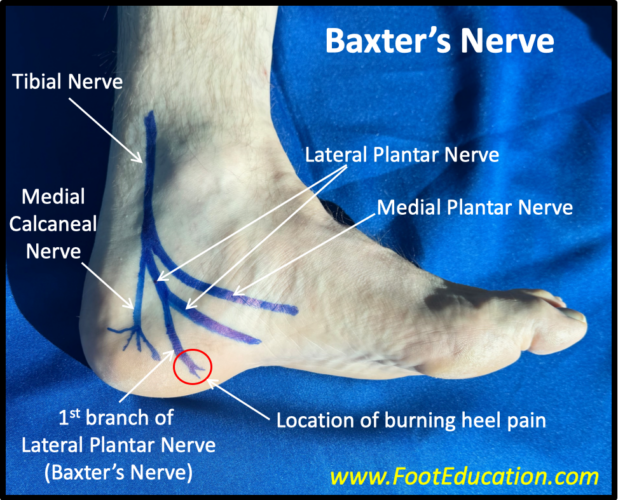Calcaneal Neuritis – Baxter’s Neuritis
What is Baxter’s Neuritis?
Calcaneal neuritis is a relatively uncommon, but potentially frustrating cause of heel pain. It is sometimes called Baxter’s neuritis. Plantar fasciitis is the most common cause of heel pain. Similar to plantar fasciitis, calcaneal neuritis will cause pain on the inside of the heel. Unlike plantar fasciitis, pain from Baxter’s neuritis has a burning component as it caused by irritation to one of the local nerves. The condition can be incited by an injury to the heel that causes bruising and scarring around the nerve. However, more commonly it comes on gradually. The source of pain is compression of a small local nerve –the first branch of the lateral planter nerve also called Baxter’s nerve. This compression irritation causes a burning discomfort along the course of the nerve (Figure 1).

What are the Symptoms of Calcaneal Neuritis
Symptoms are often worse with activity. Patients may have a limp. Direct pressure over the inside of the heel will increase discomfort, and may result in a burning sensation into the heel area (Tinel sign).
Baxter’s Neuritis Treatment
Conservative treatment of Baxter neuritis can be quite helpful. Standard treatment of calcaneal neuritis includes local tissue mobilization, use of comfort shoes, and a period of activity modification. This soft-tissue mobilization is often performed by physical therapist. This treatment is designed to break up scar tissue and allow the small nerve to move more freely. Comfort shoes will help protect the area from further repetitive irritation. Similarly, avoiding impact activities for a period of time will help locally irritation around the nerve to settle.
For some patients that have continued symptoms in spite of optimal conservative treatment a local corticosteroid injection performed under ultrasound may be beneficial, especially when combined with continued physical therapy.
Surgery for Baxter’s Neuritis
There is a small subset of patients that unfortunately will continue to do poorly in spite of optimal conservative treatment. These patients may be candidates for surgery to free up and decompress the affected Baxter nerve. However, surgery does have risks, including creating further scar around the nerve.
Edited January 23rd, 2024.